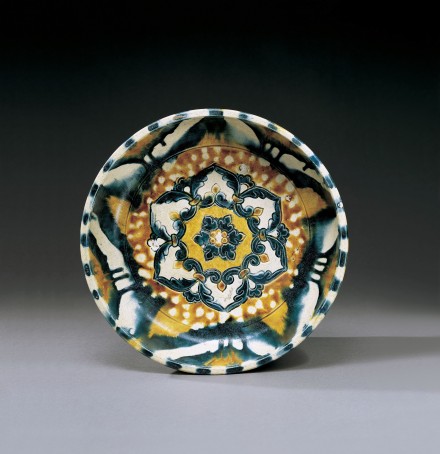J.J. Lally & Co., Oriental Art / New York City, New York
MenuPast Exhibition
Early Chinese Ceramics: An American Private Collection
March 28 - April 16, 2005

11.
A SANCAI-AND-BLUE-GLAZED POTTERY BASIN
Tang Dynasty (A.D. 618–907)
impressed in the center of the broad flat base with an elaborate medallion comprised of six linked petal-motifs formed by paired foliate scrolls glazed in blue and each enclosing a cream-glazed reserve centered with an amber-glazed petal-tip, the six large petal-motifs linked by trefoil “bridges” and encircling a stylized flowerhead with a cream-and amber-glazed center surrounded by six blue-glazed petals on an amber ground, the outer field of amber reserved with cream spots and the solidly potted steep sides decorated with blue-edged cream white chevrons on an amber ground, the cream-glazed rim decorated with bright blue spots running onto the exterior, and with a band of amber glaze on the exterior falling short of the rounded edge of the base, the rich blue glaze well controlled within the impressed designs and running in attractive streaks on the sides, the glossy surface showing slight degradation from burial, the underside left unglazed revealing the pale buff body.
Diameter 7 7⁄8 inches (20 cm)
Compare the pottery basin with very similar sancai-and-blue-glazed design, impressed with a variation of the central medallion, in the Matsuoka Museum of Art, Tokyo, illustrated in the catalogue of the Exhibition of Famous Masterpieces of Chinese Pottery and Porcelain, Tokyo, 1983, no. 13.
Another blue-and-amber-glazed basin excavated in 1974 from Sanyuan, Shaanxi province, is illustrated in Zhongguo Wenwu Jinghua Daquan, Taocijuan (Compendium of Chinese Archaeological Treasures, Ceramics), Hong Kong, 1993, no. 448, p. 129. Compare also the sancai-glazed basin impressed with a very similar medallion, from the Calmann collection, now in the Musée Guimet, Paris illustrated by Gray, Early Chinese Pottery and Porcelain, London, 1953, pl. 32.
Rawson illustrates a Tang sancai-glazed pottery tripod offering dish with very similar stamped foliate decoration in The Ornament on Chinese Silver of the Tang Dynasty, London, 1982, pl. 46, together with a printed textile found at Astana, Turfan, Xinjiang province, with a closely related medallion enclosing a bird, pl. 47 and a detail from cave 390 at Dunhuang painted with a similar design, pl. 58, where she discusses the rosette motif in detail pp. 16–18.
唐 三彩加藍印花碗 徑 20 厘米
11.
A SANCAI-AND-BLUE-GLAZED POTTERY BASIN
Tang Dynasty (A.D. 618–907)
Diameter 7 7⁄8 inches (20 cm)